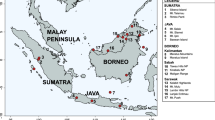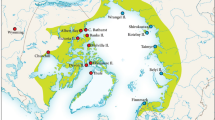Abstract
Evolutionary relationships of the scrub-birds Atrichornis were investigated using complete sequences of the recombination-activating gene RAG-1 and the proto-oncogene c-mos for two individuals of the noisy scrub-bird Atrichornis clamosus. Phylogenetic analysis revealed that Atrichornis was sister to the genus Menura (the lyrebirds) and that these two genera (the Menurae) were sister to the rest of the oscine passerines. A sister relationship between Atrichornis and Menura supports the traditional view, based on morphology and DNA hybridization, that these taxa are closely related. Similarly, a sister relationship with the remaining oscine passerines agrees with the morphological distinctiveness of Atrichornis and Menura, although this result contradicts conclusions based on DNA hybridization studies. Although Atrichornis is very well known morphologically, previous conclusions regarding its relationships were hampered by a lack of comparative knowledge of other passerines, making concurrence of the sequence data of particular significance.


Similar content being viewed by others
References
Ames PL (1971) The morphology of the syrinx in passerine birds. Peabody Mus Nat Hist Bull 37:6,194
Barker FK, Barrowclough GF, Groth JG (2002) A phylogenetic hypothesis for passerine birds: taxonomic and biogeographic implications of an analysis of nuclear DNA sequence data. Proc R Soc Lond B 269:295–308
Barker FK, Cibois A, Schikler P, Feinstein J, Cracraft J (2004) Phylogeny and diversification of the largest avian radiation. Proc Natl Acad Sci USA 101:11040–11045
Bock WJ (1972) Review of “the morphology of the syrinx in passerine birds” by P L Ames. Auk 89:899–903
Bock WJ (1985) The skeletomuscular system of the feeding apparatus of the noisy scrub-bird, Atrichornis clamosus (Passeriformes: Atrichornithidae). Rec Aust Mus 37:193–210
Bock WJ, Clench MH (1985) Morphology of the noisy scrub-bird, Atrichornis clamosus (Passeriformes: Atrichornithidae): systematic relationships and summary. Rec Aust Mus 37:243–254
Bremer K (1988) The limits of amino acid sequence data in angiosperm phylogenetic reconstruction. Evolution 42:795–803
Bremer K (1994) Branch support and tree stability. Cladistics 10:295–304
Brush AH (1979) Comparison of egg-white proteins: effect of electrophoretic conditions. Biochem Syst Ecol 7:155–165
Carlson LM, Oettinger MA, Schatz DG, Masteller EL, Hurley EA, McCormack WT, Baltimore D, Thompson CB (1991) Selective expression of RAG-2 in chicken B cells undergoing immunoglobin gene conversion. Cell 64:201–208
Chisholm AH (1951) The story of the scrub-birds. Emu 51:89–112
Christidis L, Schodde R (1991) Relationships of the Australo-Papuan songbirds – protein evidence. Ibis 133:277–285
Clench MH (1985) Body pterolysis of Atrichornis, Menura, the ‘corvid assemblage’ and other possibly related passerines (Aves: Passeriformes). Rec Aust Mus 37:115–142
Clench MH, Smith GT (1985) Morphology of the noisy scrub-bird Atrichornis clamosus (Passeriformes: Atrichornithidae): introduction, with remarks on plumage and systematic position. Rec Aust Mus 37:111–114
Doyle JJ, Doyle JL (1987) A rapid DNA isolation procedure for small quantities of fresh leaf tissue. Phytochem Bull 19:11–15
Ericson PGP, Christidis L, Cooper A, Irestedt M, Jackson J, Johansson US, Norman JA (2002a) A Gondwanan origin of passerine birds supported by DNA sequences of the endemic New Zealand wrens. Proc R Soc Lond B 269:235–241
Ericson PGP, Christidis L, Irestedt M, Norman JA (2002b) Systematic affinities of the lyrebirds (Passeriformes: Menura), with a novel classification of the major groups of passerine birds. Mol Phylogenet Evol 25:53–62
Feduccia AJ (1975a) Morphology of the bony stapes in the Menuridae and Acanthisittidae: evidence for oscine affinities. Wilson Bull 87:418–420
Feduccia AJ (1975b) Morphology of the bony stapes (columella) in the Passeriformes and related groups: evolutionary implications. Univ Kansas Mus Nat Hist Misc Publ 63:1–34
Feduccia AJ, Olson S (1982) Morphological similarities between the Menurae and the Rhinocryptidae, relict passerine birds of the Southern Hemisphere. Smithsonian Contrib Zool 366:1–22
Felsenstein J (1985) Confidence limits on phylogenies: an approach using the bootstrap. Evolution 79:783–791
Gadow H (1893) Vogel II. Systematischer Theil. In Bronn’s Klassen und Ordnung des Their-Reichs, vol 6. CF Winter, Leipzig
Garrod AH (1876) On some anatomical peculiarities which bear upon the major divisions of the Passerine birds. Part I. Proc Zool Soc Lond 1876:506–519
GeneCodes Corp (2000) Sequencher, version 4.1. GeneCodes Corp, Ann Arbor, Mich.
Gould J (1844) Description of Atrichia clamosa. Proc Zool Soc Lond 1844:1–2
Gould J (1865) Handbook to the birds of Australia, vol 1. J Gould, London
Groth JG, Barrowclough GF (1999) Basal divergences in birds and phylogenetic utility of the nuclear RAG-1 gene. Mol Phylogenet Evol 12:115–123
Mayr E, Amadon D (1951) A classification of recent birds. Am Mus Novit 1496:1–42
Morlion ML (1985) Pterylosis of the wing and tail in the noisy scrub-bird, Atrichornis clamosus, and Superb Lyrebird, Menura novaehollandiae (Passeriformes: Atrichornithida and Menuridae). Rec Aust Mus 37:143–156
Posada D, Crandall KA (1998) MODELTEST: testing the model of DNA substitution. Bioinformatics 14:817–818
Raikow RJ (1985) Systematic and functional aspects of the locomotor system of the scrub-birds, Atrichornis, and lyrebirds, Menura (Passeriformes: Atrichornithidae and Menuridae). Rec Aust Mus 37:211–228
Ramsay EP (1866) Description of a new species of Atrichia (A. rufescens) from the Richmond River, New South Wales. Proc Zool Soc Lond 1866:438–439
Rich PV, McEvey AR, Baird RF (1985) Osteological comparison of the scrub-birds, Atrichornis, and the lyrebirds, Menura (Passeriformes: Atrichornithidae and Menuridae). Rec Aust Mus 37:165–192
Saint KM, Austin CC, Donnellan SC, Hutchinson MN (1998) C-mos, a nuclear marker useful for squamate phylogenetic analysis. Mol Phylogenet Evol 10:259–263
Schatz DG, Oettinger MA, Baltimore D (1989) The V(D)J recombination activating gene, RAG-1. Cell 59:1035–1048
Schmidt M, Oskarsson MK, Dunn JK, Blair DG, Hughes S, Propost F, Vande Woude GF (1988) Chicken homolog of the mos proto-oncogene. Mol Cell Biol 8:923–929
Sclater PL (1880) Remarks on the present state of the Systema avium. Ibis 1880:340–350
Shufeldt RW (1890) The myology of the raven (Corvus corax sinuatus). MacMillan, London
Sibley CG (1970) A comparative study of the egg-white proteins of passerine birds. Bull Peabody Mus Nat Hist 32:1-131
Sibley CG (1974) The relationships of the lyrebirds. Emu 74:65–79
Sibley CG, Ahlquist JE (1985) The phylogeny and classification of the Australo-Papuan passerine birds. Emu 85:1–14
Sibley CG, Ahlquist JE (1990) Phylogeny and classification of birds. Yale University Press, New Haven
Smith GT (1985) Natal downs and plumage changes in the noisy scrub-bird Atrichornis clamosus (Passeriformes: Atrichornithidae). Rec Aust Mus 37:157–164
Sorenson MD (1999) TreeRot, version 2. Boston University, Boston
Swofford DS (2002) Phylogenetic analysis using parsimony*, version 4.0b10. Sinauer, Sunderland
Webster HO (1962a) Rediscovery of the noisy scrub-bird Atrichornis clamosus. West Aust Nat 8:57–59
Webster HO (1962b) Rediscovery of the noisy scrub-bird Atrichornis clamosus – further observations. West Aust Nat 8:81–84
Wetmore A (1960) A classification for the birds of the world. Smithsonian Misc Coll 139:1–37
Zusi RL (1985) Muscles of the neck, trunk and tail in the noisy scrub-bird, Atrichornis clamosus, and Superb Lyrebird, Menura novaehollandiae (Passeriformes: Atrichornithidae and Menuridae). Rec Aust Mus 37:229–242
Acknowledgements
We thank Sarah Comer of CALM (Department of Conservation and Land Management, Western Australia) for graciously providing blood samples of Atrichornis clamosus, and we thank Ian Mason for initially contacting Sarah about obtaining samples for the Australian National Wildlife Collection. We are grateful to the Myer Foundation for generous financial support and to Richard Zusi and two anonymous reviewers for helpful comments on the manuscript.
Author information
Authors and Affiliations
Corresponding author
Additional information
Communicated by M. Wink.
Rights and permissions
About this article
Cite this article
Chesser, R.T., Have, J.t. On the phylogenetic position of the scrub-birds (Passeriformes: Menurae: Atrichornithidae) of Australia. J Ornithol 148, 471–476 (2007). https://doi.org/10.1007/s10336-007-0174-9
Received:
Revised:
Accepted:
Published:
Issue Date:
DOI: https://doi.org/10.1007/s10336-007-0174-9




